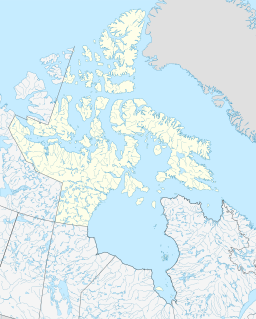| Roes Welcome Sound | |
|---|---|
 The Roes Welcome Sound in 2017 | |
| Coordinates | 65°01′N 086°40′W / 65.017°N 86.667°W[1] |
| Basin countries | Canada |
| Max. length | 290 km (180 mi) |
| Max. width | 24 to 113 km (15 to 70 mi) |
| Settlements | Uninhabited |
Roes Welcome Sound is a long channel at the northwest end of Hudson Bay in the Kivalliq Region, Nunavut, Canada between the mainland on the west and Southampton Island on the east. It opens south into Hudson Bay. Its north end joins Repulse Bay[2] which is connected east through Frozen Strait to Foxe Basin, thereby making Southampton Island an island. Wager Bay is a western branch. It is situated 200 km (120 mi) north of Marble Island.[3] Roes Welcome Sound measures 290 km (180 mi) long, and 24 to 113 km (15 to 70 mi) wide.[4]
In 1613 it was reached by Thomas Button who called it 'Ne Ultra'. It is named after Sir Thomas Roe, friend and sponsor of explorer Luke Foxe's 1631 Arctic voyage.[5][6] Captain William Edward Parry, trying to find the Northwest Passage during his 1821 voyage, wrote:[7]
On an inspection of the charts, I think it will also appear probable that a communication will one day be found to exist between this inlet (Prince Regent's) and Hudson's Bay, either through the broad and unexplored channel called Sir Thomas Roe's Welcome, or through Repulse Bay, which has not yet been satisfactorily examined.
— William Edward Parry, Arctic explorations and discoveries during the nineteenth century.
Roes Welcome Sound is a bowhead whale migratory path.[8]
- ^ "Maittuq". Geographical Names Data Base. Natural Resources Canada.
- ^ "Repulse Bay". Geographical Names Data Base. Natural Resources Canada.
- ^ "Marble Island, experience the mystery". marbleisland.ca. Retrieved 9 April 2008.
- ^ "Roes Welcome Sound". The Columbia Gazetteer of North America. Archived from the original on 10 May 2005. Retrieved 9 April 2008.
- ^ "Thomas James and Luke Foxe". princeton.edu. Retrieved 9 April 2008.
- ^ "JSTOR: The History of American Ornithology before Audubon". Retrieved 9 April 2008.
- ^ Smucker, Samuel Mosheim; Allison, W.L. (1886). Arctic explorations and discoveries during the nineteenth century. Being detailed accounts of the several expeditions to the north seas, both English and American, conducted by Ross, Parry, Back, Franklin, M'Clure, Dr. Kane, and others, including the long and fruitless efforts and failures in search of Sir John Franklin. Ed. and completed to 1855. New York: J.W. Lovell. ISBN 9780665169755. OCLC 1580359.
Roe's welcome.
- ^ Ross, W.G. (1974). "Distribution, Migration, and Depletion of Bowhead Whales in Hudson Bay, 1860 to 1915". Arctic and Alpine Research. 6 (1). JSTOR: 85–98. doi:10.2307/1550373. JSTOR 1550373.
